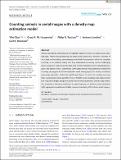Counting animals in aerial images with a density map estimation model
Abstract
Animal abundance estimation is increasingly based on drone or aerial survey photography. Manual postprocessing has been used extensively; however, volumes of such data are increasing, necessitating some level of automation, either for complete counting, or as a labour-saving tool. Any automated processing can be challenging when using such tools on species that nest in close formation such as Pygoscelis penguins. We present here a customized CNN-based density map estimation method for counting of penguins from low-resolution aerial photography. Our model, an indirect regression algorithm, performed significantly better in terms of counting accuracy than standard detection algorithm (Faster-RCNN) when counting small objects from low-resolution images and gave an error rate of only 0.8 percent. Density map estimation methods as demonstrated here can vastly improve our ability to count animals in tight aggregations and demonstrably improve monitoring efforts from aerial imagery.
Citation
Qian , Y , Humphries , G , Trathan , P , Lowther , A & Donovan , C R 2023 , ' Counting animals in aerial images with a density map estimation model ' , Ecology and Evolution , vol. 13 , no. 4 , e9903 . https://doi.org/10.1002/ece3.9903
Publication
Ecology and Evolution
Status
Peer reviewed
ISSN
2045-7758Type
Journal article
Description
Funding: WWF (UK) supported PNT under grant GB095701, which also provided funds to develop the training datasets.Collections
Items in the St Andrews Research Repository are protected by copyright, with all rights reserved, unless otherwise indicated.

